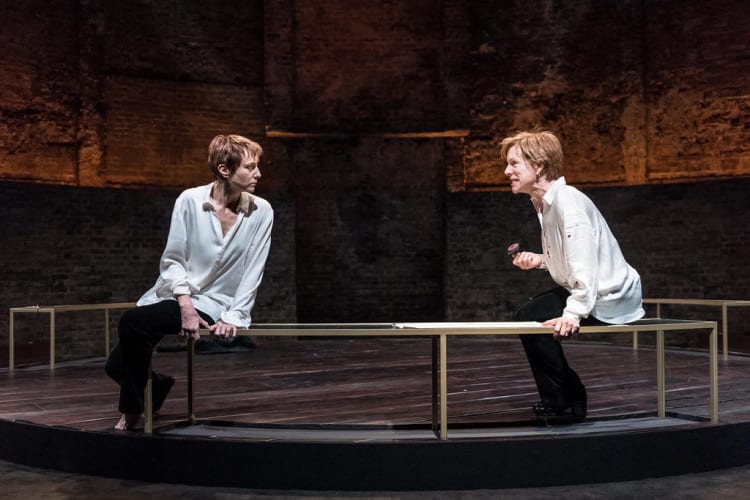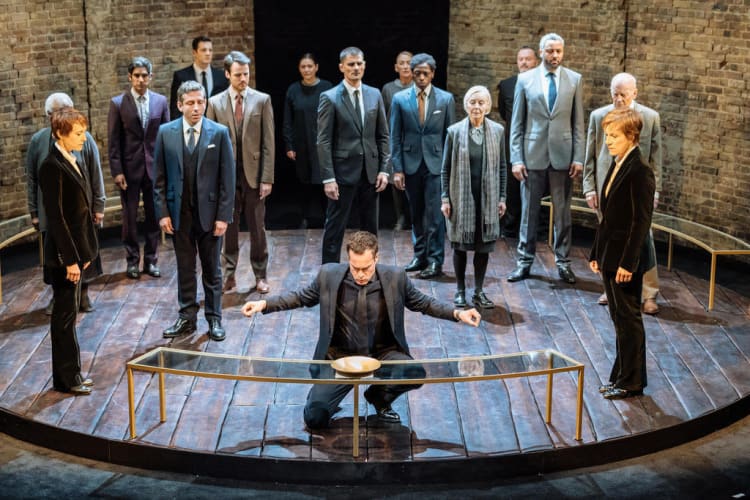The cast assembles, with Juliet Stevenson and Lia Williams, (downstage left and right, respectively) clad in matching dark trouser suits. “Heads!” calls Stevenson.
John Light (who will play the Earl of Leicester, long-time suitor of the English queen and, perhaps, sometime lover of the Queen of Scots) steps forward, stooping to scrutinise a bowl or pot (as if reading the runes) where, one assumes, the coin lies already tossed. Without a word, he steps back, turns towards Stevenson and leads the cast in a respectful bow.
Tonight, then, she will play Elizabeth I, Queen of England. Meanwhile, Williams has her jacket dragged roughly from her back, and is led away to assume the title role.
One can see the arguments for this device—two lead roles, two actors alternating between them. Danny Boyle employed it with Benedict Cumberbatch and Jonny Lee Miller, in his production of Frankenstein. As with Frankenstein and his creature, Robert Icke’s adaptation of Schiller’s Mary Stuart (1800) offers the thesis that these two characters (Elizabeth and Mary) are but two sides of a single coin.
In practical terms, alternating roles may also mitigate against boredom or complacency in a lengthy run and help circumvent resentments between your twin stars as to which has the juicier role. Does it also hamper an actor's ability to fully inhabit a role? Something to ponder.
Three hours in the company of two of our finest actors ought to be an experience to treasure but, tantalising glimpses aside, the treasure remains unmined. There are several reasons for this. A lesser, but not insignificant, cause is the half dozen screens hanging, left and right through the auditorium.
It’s hard to know if, fully functioning, these might make a useful contribution to the show. Tonight, they are under attack from those gremlins that blight technologies—sometimes flickering distractingly to no apparent purpose; at one point flashing up an advert for the Theatre Royal, York. Even when the technology does its job, what do we get? A close-up of Elizabeth signing Mary’s death warrant. So what? We know this is what she is doing, without resort to TV close-ups.
Icke’s adaptation is not without strengths, but the large auditorium of The Lowry’s Lyric Theatre (five times the size of the Almeida, where this production was born) sucks the air out of much of it. The Lyric has a notoriously dead acoustic, such that sound that is clear to the central block of seats in stalls and circle can be damagingly muffled for those seated to right and left. Add to this the constant incidental background music and the actors might just as well mime as attempt the subtle and nuanced delivery of dialogue.
The dramatic structure of the piece also creates problems. The climactic scene happens at the close of act 3, when the two monarchs come face-to-face (an encounter imagined by Schiller, which never happened in real life). Proud Mary is also smart and articulate here, understanding that her freedom and even her life depend upon establishing a connection with Elizabeth. She prostrates herself, she concedes victory to the English Queen and renounces all claim on the throne of England. Mary holds out the hand of friendship, peace and unity and, for a moment, it seems like the haughty Elizabeth will raise up her captive ‘sister’, building a bond between queens, between nations, between women, perhaps even between religions.
But Mary Stuart’s submission comes with a demand for acknowledgement of the wrong she has been done. “I came to Engand as a refugee, needing asylum,” she complains, insisting on her entitlement to better treatment than the years of imprisonment she was given. Elizabeth, refusing to accept blame, repeats accusations that Mary plotted against her and threatened her country’s way of life with her despised Catholicism. Her attempted humility thrown back in her face, Mary is provoked and launches a vituperative assault on her rival. Finally, the two monarchs have to be physically dragged apart by their attendant subjects.
Icke’s reimagining of this scene, as a confrontation between refugee and unwilling, suspicious hostess, is powerful and thought-provoking. The dialogue zings and the two principals, at last permitted to trade artistic blows, offer the promise of something magnificent. Sadly, this is the high-point of the production and we have only reached the interval.
What remains—notwithstanding an impressive closing tableau vivant, with Elizabeth locked tight into the queenly robes we recognise (“the crown is a prison,” she protests)—never approaches such heights.
Elliot Levey, all Sir Humphrey as Lord Burleigh, in his machiavellian arguments for the death of the Scots queen, John Light as a slimily charming Leicester with a sharp eye for self-preservation, Michael Byrne as the weary but wise Lord Talbot and Carmen Munroe as Kennedy, a tower of strength for her nursling Queen Mary, are the pick of a strong supporting cast.
It is, of course, unrealistic to expect The Lowry to stage this in the 466-seater Quays Theatre when they can sell out the Lyric’s 1,730, but, oh, how much more memorable the night could have been.

